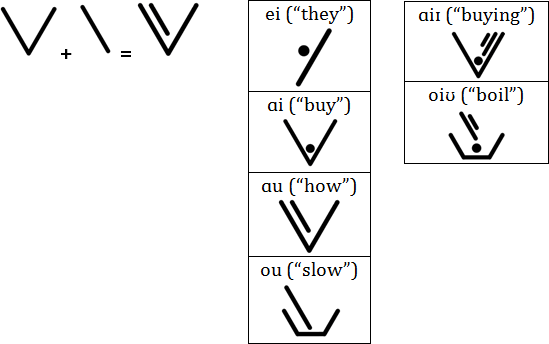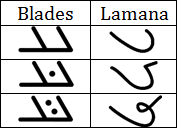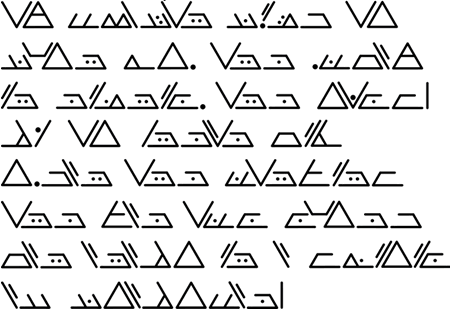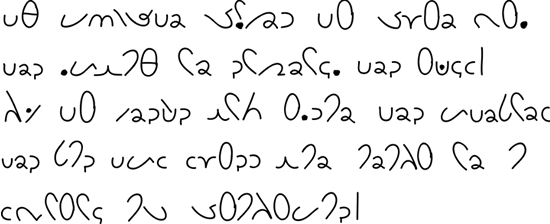Ryonic script was developed in early 2013 by Jasper Danielson as part of an aesthetic exercise to design a script that was both beautiful and easy to read and write.
There are two different forms of Ryonic script that can be used: Ryonic Blades and Lamana. Blades is a highly angular script, designed entirely around straight lines and their intersections. In fact, every letter in Blades can be broken down into lines intersecting at either 60° or 120° and dot-diereses. Lamana is a curved form of Ryonic script with more flowing letters and few hard angles.
Ryonic Blades has two different classes of letters-consonants and vowels.
Ryonic Blades is a featural script, meaning that the different components of each of the letters correspond to different features of their pronunciation. Consonants in Blades each have three components, corresponding to manner, voicing, or place of articulation.
Each consonant in Blades has a "base line"-a long horizontal line that forms the base of the letter. Above this line is placed a short diagonal line, known as the "stem," either on the right or left side of the base line. This stem specifies the voicing of the consonant: a stem on the left corresponds to unvoiced and a stem on the right corresponds to voiced.


Semi-vowels are treated as consonants, but do not follow the featural conventions of the other consonants. They are defined as follows:


Ryonic has seven basic vowels, defined phonetically. All other vowels are expressed as combinations of these basic vowels.

Note that, in Ryonic, a vowel is required for syllabic consonants that are not semi-vowels (IE: .N or .T). The default vowel for this purpose is the 6th one above, though the 5th may also be used.
The seven basic vowels can be combined to make more structurally complex vowels, commonly referred to as diphthongs and triphthongs. Each successive vowel is written slightly smaller and above the previous vowel. In order to read or write compound vowels in Ryonic, simply start at the bottom and work up. For example:

Lamana is a curved form of Ryonic script. Every letter in Lamana is directly related to every letter in Blades by the following relationship:






All human beings are born free and equal in dignity and rights. They are endowed with
reason and conscience and should act towards one another in a spirit of brotherhood.
(Article 1 of the Universal Declaration of Human Rights)
Constructed scripts for: Ainu | Arabic | Chinese languages | Dutch | English | Hawaiian | Hungarian | Japanese | Korean | Lingala | Malay & Indonesian | Persian | Tagalog / Filipino | Russian | Sanskrit | Spanish | Taino | Turkish | Vietnamese | Welsh | Other natural languages | Colour-based scripts | Tactile scripts | Phonetic/universal scripts | Constructed scripts for constructed languages | Adaptations of existing alphabets | Fictional alphabets | Magical alphabets | A-Z index | How to submit a constructed script
[top]
You can support this site by Buying Me A Coffee, and if you like what you see on this page, you can use the buttons below to share it with people you know.

If you like this site and find it useful, you can support it by making a donation via PayPal or Patreon, or by contributing in other ways. Omniglot is how I make my living.
Note: all links on this site to Amazon.com, Amazon.co.uk
and Amazon.fr
are affiliate links. This means I earn a commission if you click on any of them and buy something. So by clicking on these links you can help to support this site.
[top]